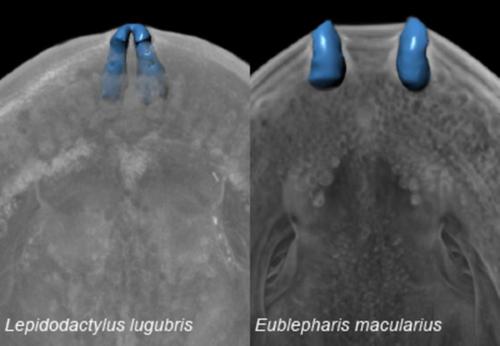当前位置:
X-MOL 学术
›
J. Morphol.
›
论文详情
Our official English website, www.x-mol.net, welcomes your
feedback! (Note: you will need to create a separate account there.)
Do all geckos hatch in the same way? Histological and 3D studies of egg tooth morphogenesis in the geckos Eublepharis macularius Blyth 1854 and Lepidodactylus lugubris Duméril & Bibron 1836
Journal of Morphology ( IF 1.5 ) Pub Date : 2020-08-17 , DOI: 10.1002/jmor.21249 Mateusz Hermyt 1 , Brian Metscher 2 , Weronika Rupik 1
Journal of Morphology ( IF 1.5 ) Pub Date : 2020-08-17 , DOI: 10.1002/jmor.21249 Mateusz Hermyt 1 , Brian Metscher 2 , Weronika Rupik 1
Affiliation

|
The egg tooth of squamates evolved to facilitate hatching from mineralized eggshells. Squamate reptiles can assist their hatching with a single unpaired egg tooth (unidentates) or double egg teeth (geckos and dibamids). Egg tooth ontogeny in two gekkotan species, the leopard gecko Eublepharis macularius and the mourning gecko Lepidodactylus lugubris, was compared using microtomography, scanning electron microscopy, and light microscopy. Investigated species are characterized by different hardnesses of their eggshells. Leopard geckos eggs have a relatively soft and flexible parchment (leathery) shell, while eggshells of mourning geckos are hard and rigid. Embryos of both species, like other Gekkota, have double egg teeth, but the morphology of these structures differs between the investigated species. These differences in shape, localization, and spatial orientation were present from the earliest stages of embryonic development. In mourning gecko, anlagen of differentiating egg teeth change their position on the palate during embryonic development. Initially they are separated by condensed mesenchyme, but later in development, their enamel organs are connected. In leopard geckos, the localization of egg tooth germs does not change, but their spatial orientation does. Egg teeth of this species shift from inward to outward orientation. This is likely related to differences in structure and mechanical properties of eggshells in the studied species. In investigated species, two hatching mechanisms are possible during emergence of young individuals. We speculate that mourning geckos break the eggshell through puncturing action with egg teeth, similar to the pipping phase of chick and turtles embryos. Egg teeth of leopard geckos cut egg membranes similarly to most squamates. Our results also revealed differences in egg tooth implantation between Gekkota and Unidentata: gekkotan egg teeth are subthecodont (in shallow sockets), while those in unidentates are acrodont (attached to the top of the alveolar ridge). © 2020 Wiley Periodicals LLC
中文翻译:

所有壁虎的孵化方式都一样吗?壁虎 Eublepharis macularius Blyth 1854 和 Lepidodactylus lugubris Duméril & Bibron 1836 中卵牙形态发生的组织学和 3D 研究
有鳞动物的卵齿进化为促进从矿化蛋壳孵化。有鳞爬行动物可以用单个未配对的卵齿(无齿)或双卵齿(壁虎和双歧杆菌)帮助它们孵化。使用显微断层扫描、扫描电子显微镜和光学显微镜比较了两种壁虎物种,豹纹壁虎 Eublepharis macularius 和哀壁虎 Lepidodactylus lugubris 的卵牙个体发育。被调查物种的特点是它们的蛋壳硬度不同。豹纹壁虎蛋有一个相对柔软和灵活的羊皮纸(皮革)外壳,而哀悼壁虎的蛋壳又硬又硬。与其他 Gekkota 一样,这两个物种的胚胎都有双卵齿,但这些结构的形态在所研究的物种之间有所不同。这些形状、定位的差异,和空间取向从胚胎发育的最早阶段就存在。在哀壁虎中,分化蛋牙的原原素会在胚胎发育过程中改变它们在上颚上的位置。最初它们被浓缩的间充质隔开,但在发育后期,它们的釉质器官是相连的。在豹纹壁虎中,卵牙胚的定位不会改变,但它们的空间方向会改变。该物种的蛋牙从向内转向向外。这可能与所研究物种的蛋壳结构和机械特性的差异有关。在被调查的物种中,在年轻个体出现期间可能有两种孵化机制。我们推测哀壁虎是通过用蛋齿刺破蛋壳来打破蛋壳的,类似于小鸡和海龟胚胎的拔壳阶段。豹纹壁虎的卵齿与大多数有鳞类动物类似,可以切割卵膜。我们的研究结果还揭示了 Gekkota 和 Unidentata 之间在卵牙植入方面的差异:gekkotan 的卵牙是 subthecodont(在浅窝中),而无齿的那些是 acrodont(附着在牙槽脊的顶部)。© 2020 威利期刊有限责任公司
更新日期:2020-08-17
中文翻译:

所有壁虎的孵化方式都一样吗?壁虎 Eublepharis macularius Blyth 1854 和 Lepidodactylus lugubris Duméril & Bibron 1836 中卵牙形态发生的组织学和 3D 研究
有鳞动物的卵齿进化为促进从矿化蛋壳孵化。有鳞爬行动物可以用单个未配对的卵齿(无齿)或双卵齿(壁虎和双歧杆菌)帮助它们孵化。使用显微断层扫描、扫描电子显微镜和光学显微镜比较了两种壁虎物种,豹纹壁虎 Eublepharis macularius 和哀壁虎 Lepidodactylus lugubris 的卵牙个体发育。被调查物种的特点是它们的蛋壳硬度不同。豹纹壁虎蛋有一个相对柔软和灵活的羊皮纸(皮革)外壳,而哀悼壁虎的蛋壳又硬又硬。与其他 Gekkota 一样,这两个物种的胚胎都有双卵齿,但这些结构的形态在所研究的物种之间有所不同。这些形状、定位的差异,和空间取向从胚胎发育的最早阶段就存在。在哀壁虎中,分化蛋牙的原原素会在胚胎发育过程中改变它们在上颚上的位置。最初它们被浓缩的间充质隔开,但在发育后期,它们的釉质器官是相连的。在豹纹壁虎中,卵牙胚的定位不会改变,但它们的空间方向会改变。该物种的蛋牙从向内转向向外。这可能与所研究物种的蛋壳结构和机械特性的差异有关。在被调查的物种中,在年轻个体出现期间可能有两种孵化机制。我们推测哀壁虎是通过用蛋齿刺破蛋壳来打破蛋壳的,类似于小鸡和海龟胚胎的拔壳阶段。豹纹壁虎的卵齿与大多数有鳞类动物类似,可以切割卵膜。我们的研究结果还揭示了 Gekkota 和 Unidentata 之间在卵牙植入方面的差异:gekkotan 的卵牙是 subthecodont(在浅窝中),而无齿的那些是 acrodont(附着在牙槽脊的顶部)。© 2020 威利期刊有限责任公司











































 京公网安备 11010802027423号
京公网安备 11010802027423号